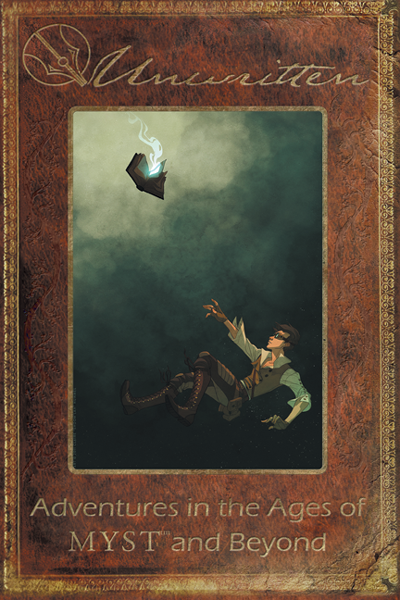Back in November 2013, the game had a successful Kickstarter campaign, raising over $35,000. After a year and half of hard graft, the team delivered in May 2015. What is Unwritten? It’s an RPG of the Myst computer game series that uses FATE core for its mechanics. As I’ve played neither, this book will also get tested on how well it introduces setting and system.
Setting and Mechanics
The Myst games were about exploring the remnants and fallout from the collapse of an ancient civilisation that had set up home in a cavern under New Mexico. What made this people special was their ability to write books that acted as portals to other realities, called Ages. The player in the games traverses these ages, solving puzzles and getting into adventures. The RPG intends to provide the tabletop version of that experience. Whilst all the setting details needed to play are in the core book, it could have been placed earlier in the text or there be short summary near the beginning. I felt adrift in the terminology and nuances of the Myst world, finding firming ground once I was later in the book. It helps there is a synopsis supplement of the games and novels that form the Myst cannon.
The core FATE mechanic is simple: Invoke an aspect of the character, apply relevant skills and roll to determine the result. Superb subtly comes from the depth and complexity that can be achieved with the aspects, as the players are free to create them to match their narrative needs. The aspect system applies to all things in the game. Equipment, locations and hazards; all have aspects that can be invoked. A large proportion of the book is given over to detailing and explaining the FATE system. The reskinning is done very well and I was able to quickly understand both FATE and how it works with the Myst setting. All the skills are fully explained with in setting examples, as is the resolution system. I was very pleased to see a two page system summary that quickly introduced the key terms.
It is FATE’s aspects that grant easy access to the most exciting part of Unwritten. No matter the complexity of plot or puzzles, a computer game always has to put limits on player creativity. Role playing games do not. Thus one of the key parts of Myst is now unlocked to the players – writing their own Ages. No small task, the game has detailed yet flowing guidance on using the Art of Writing which exploits FATE’s aspects. An Age, like everything else, is defined by its aspects, giving free creative control without endless mechanical details. The ability for the players to write and explore new Ages opens up vast realms of play and dramatic opportunities.
Content
The core book does the basics very well. The PDF version I reviewed has hyperlinks whenever lengthy topics were mentioned that you might want to move quickly to. A lengthy index and glossary of terms are found at the back of the book, counterpointing the simple hyperlinked contents page. Rather than set out a locked and restrictive version of the setting, the book instead suggests a lengthy series of questions. This ranges from significant variations from the Myst canon to deciding how many people now reside in the cavern. It provides a solid framework for the players and GM to setup the Myst RPG they want to play, encouraging a solid engagement of characters to narrative. This is all supported by consistent examples using the sample characters. To help with immersion and building puzzles there’s a D’ni primer supplement full of notes on the D’ni language and symbolism. This is much needed information as puzzle crafting will be a major part of game master preparation.
What puzzled me most about the book’s content was the twenty four pages of in character, in setting handwritten notes at the front of the book. In addition to being an annoyance to move through before you get to the contents page, if you’re not familiar with Myst, they’re a bewildering mess of unfamiliar terms and names. Some kind of introductory note as to what the letters are would have helped as would scattering them through the document to illustrate topics. Whilst several important characters from the canon are detailed with their aspects, there’s a lack of example NPCs. It may not be difficult to generate them, but some additional sample NPCs would have been good to see.
Style and Graphics
Parchment and handwriting is the artwork style of the book, fitting nicely with the strong theme of writing in the setting. It’s carried out simply and doesn’t get in the way of the text. Headings are clear, important points highlighted and the examples easily distinguished. However, the style limits the colour palette that can be used, leading to a book that is monotonously black and pale brown. A different background would have let the book designer use a wider colour palette.
There are over 70 pieces of artwork in the book, liberally distributed throughout the text. They vary in quality and style, a function of the multiple artists working on the project. The art that works best are the simpler pen and ink drawings as they sit more easily onto the parchment. Larger images that look like impressionist watercolours also work well. The artwork also doesn’t seem to connect with the surrounding text, often seemingly placed just to break up the flow or mark pauses between chapters and sections.
Summary
With both setting and the mechanics fully and well explained, Unwritten is a good use of the FATE system. It’s clearly been written with detail and love for the original Myst material. Whilst the presentation could benefit from some fine tuning, the layout is competent and you can find information quickly. I would certainly recommend this book for RPG fans of Myst, FATE and puzzles. You can find it at: http://www.unwrittenrpg.com/

